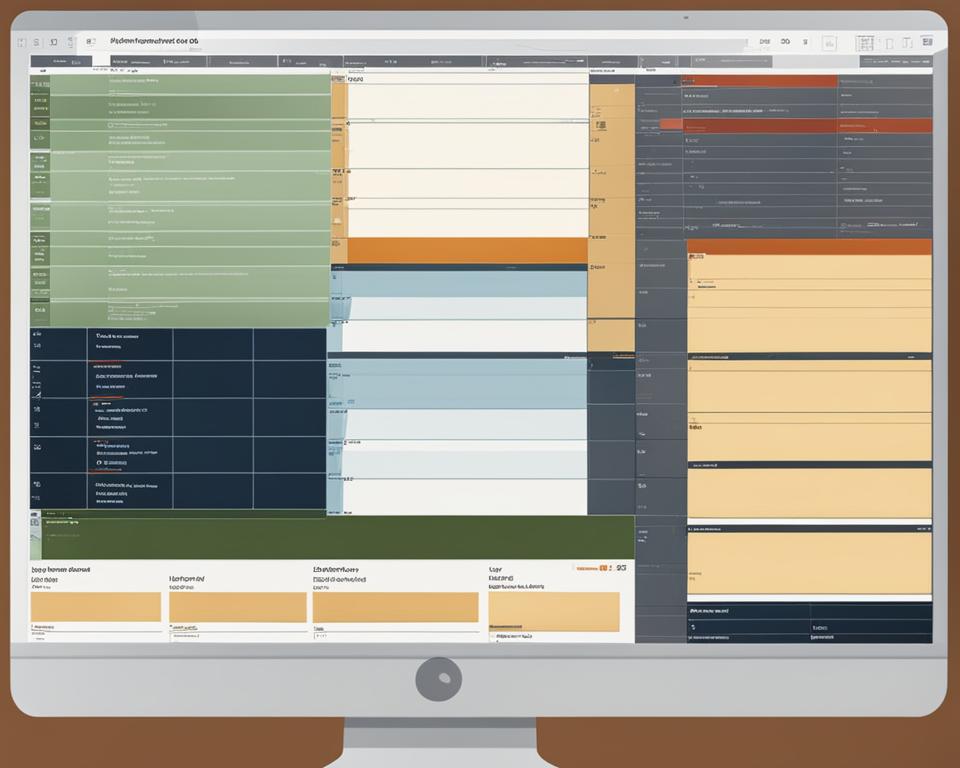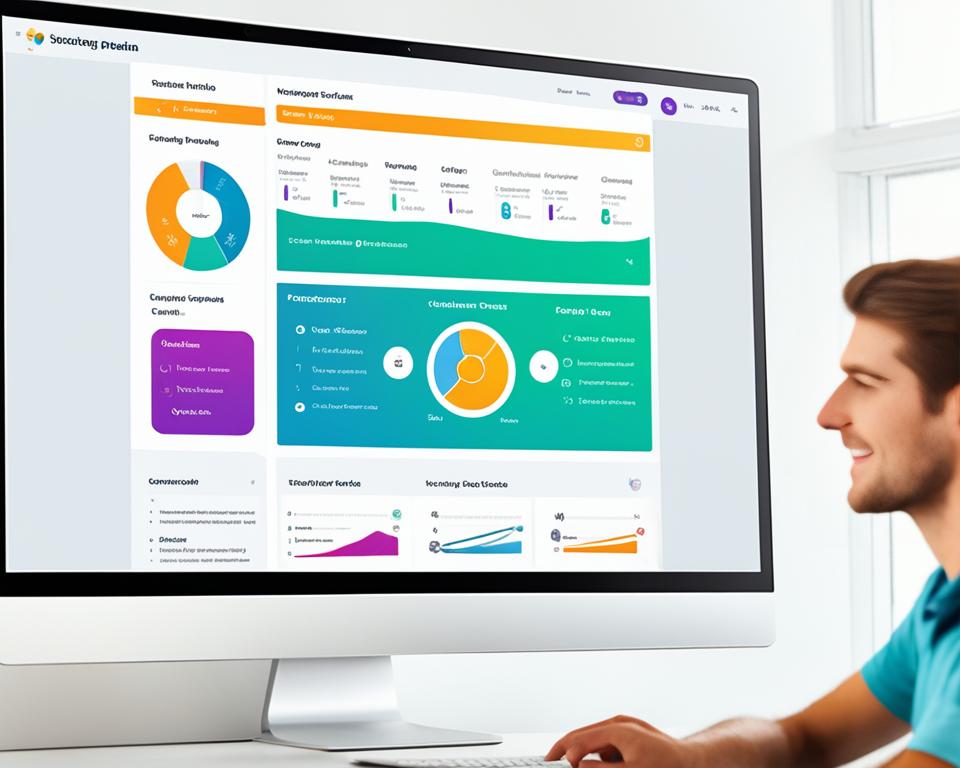Embarking on the journey of exam preparation can often be as formidable as the test itself. With the right Exam Prep Guide, individuals can navigate this path with confidence and ease. In today’s highly competitive world, achieving exam success necessitates not just hard work but also smart strategies. Arming oneself with a wealth of study tips, deploying effective test-taking strategies, meticulously organizing study materials, and maintaining a disciplined study schedule are paramount in ensuring test readiness. The prospect of acing exams is no longer shrouded in mystery; it’s a clear target awaiting to be hit with precision and preparation.
The demand for robust guidance on exam preparation has never been higher, and we are here to deliver exactly that. From understanding the importance of a well-tailored study schedule that fits your personal routine, to profound insights on the types of study materials that can make or break your exam success—our comprehensive guide is the beacon you need. Whether you are a seasoned professional or a nervous first-time test-taker, these insights transcend all levels of experience and are designed to offer a blueprint for success.
Key Takeaways
- Designing a tailored study schedule is crucial for consistent exam preparation.
- Understanding and utilizing one’s learning style leads to more efficient study sessions.
- Effective test-taking strategies can dramatically improve performance under exam conditions.
- Well-organized study materials contribute to clarity and ease during revision.
- Test readiness is achieved not just through study but also by maintaining overall well-being.
- Practice tests are a key component of any impactful Exam Prep Guide.
Creating Your Study Schedule to Maximize Exam Prep
The foundation of effective exam preparation begins with a well-constructed study schedule. Tailoring this schedule to your personal needs and academic goals is a critical step towards achieving test readiness. Recognizing that a study schedule is more than just a calendar of study sessions, it’s an actionable plan that equips you with the structure and discipline necessary for exam success. By committing to a personalized study schedule, you can divide and conquer your syllabus, ensuring that no topic is left untouched and every study tip is applied.
Benefits of Early Planning
Early planning of your study schedule brings numerous advantages. It sets a proactive approach to tackling the syllabus, ensuring that you make the most of every study session. By starting early, you systematically reduce the overwhelming volume of content into manageable segments. Early planners benefit from a more relaxed study pace, allowing for deeper comprehension and retention of material, which are vital elements in any exam preparation strategy.
Designing an Effective Study Calendar
Constructing an effective study calendar requires a strategic approach. It involves identifying peak productivity periods during your day and aligning those with the most challenging study topics. An effective study calendar not only schedules for study sessions but also integrates necessary breaks for cognitive rest and recovery. This approach ensures sustained attention and energy levels, enhancing the overall quality of your study time.
| Day/Time | Study Topic | Study Activity | Duration |
|---|---|---|---|
| Monday 3-5 PM | Concept Review | Flashcards | 2 hours |
| Tuesday 6-8 PM | Practice Problems | Problem Solving | 2 hours |
| Wednesday 3-5 PM | Chapter Summaries | Reading/Notetaking | 2 hours |
| Thursday 6-8 PM | Mock Exam | Timed Practice Test | 2 hours |
| Friday 3-4 PM | Subject Review | Group Discussion | 1 hour |
| Saturday 10-12 AM | Weak Areas | Targeted Study | 2 hours |
| Sunday OFF | Rest & Recuperation | — | — |
By following these guidelines and utilizing a structured study calendar, one is set on the course toward effective exam prep. Each season in your study schedule brings you one step closer to your goal, paving the way toward not just learning, but mastering the material essential for acing your exams.
The Importance of a Conducive Study Environment
For aspirants focused on achieving exam success, the quality of their study environment is a crucial piece of the puzzle. A well-crafted study space not only enhances concentration but also sets the stage for effective assimilation of study materials. It is the sanctuary where test readiness is cultivated, and potential is realized.
A conducive study environment goes beyond the physical space; it is an ecosystem that supports cognitive function and minimizes stress. This environment helps to filter out distractions and aligns deeply with the user’s personal study preferences, paving the way for a seamless learning experience.
Eliminating Distractions for Improved Focus
In the pursuit of maintaining a pristine study environment, minimizing interruptions is key. This can range from silencing mobile devices to adopting software that blocks distracting websites during study hours. Each action taken to reduce distractions sharpens the focus and fortifies the mind’s ability to retain information, ultimately leading to greater academic results.
Essentials for a Productive Study Space
The cornerstone of a productive study space includes several non-negotiable elements. An uncluttered desk represents a clear mind, free of chaos. This, paired with the necessary study materials within arm’s reach, sets the tone for uninterrupted study sessions. Proper lighting facilities reduce eye strain during long study intervals, while an ergonomically designed chair sustains posture and reduces physical discomfort, allowing for longer, more productive study periods. Together, these essentials foster a serene study environment that mitigates anxiety and maximizes the brain’s ability to learn and recall.
Every element in the dedicated study space contributes to a conducive atmosphere for academic excellence. Embracing this disciplined approach to creating and maintaining a study environment is a testament to a student’s commitment to learning and personal growth, both keys to unlocking the door to exam success.
Adapting Study Habits to Your Learning Style
When diving into exam preparation, recognizing and adapting to your unique learning style not only optimizes your study sessions but also enhances your ability to grasp and retain complex concepts. Understanding your individual learning preferences is a powerful step towards customizing your study strategy, ensuring that each study tip and practice aligns with the most effective way for you to process and remember information.

Visual, auditory, and kinesthetic are among the most common learning styles, each requiring distinct approaches to studying. By crafting your exam preparation tactics around your learning style, not only will your study efficiency soar, but your confidence in mastering the material will also skyrocket.
Identifying Your Personal Learning Preferences
To unlock the potential of your learning style, start with self-evaluation. Reflect on past learning experiences — when you were most engaged and retained information effectively. Customize your study environment with tools and resources that resonate with your learning style. Whether it’s colorful infographics, detailed auditory recordings, or interactive simulations, aligning your study materials and strategies to your learning style can be the game-changer in your exam preparation.
- Visual learners might benefit from creating mind maps or charts to organize thoughts and see connections.
- Auditory learners can record their notes and listen back, or engage in discussions to deepen understanding.
- Kinesthetic learners often excel when they can use their hands or move around, such as through role-playing or building models.
Recognizing and embracing your learning style isn’t just about improving your study habits; it’s a commitment to a personalized path towards academic success. It’s about transforming the wealth of knowledge into a format that speaks directly to you. Study tips, exam preparation techniques, and learning resources become immensely powerful when tailored to your unique way of learning, leading to a more profound, enduring understanding of the material.
Physical Health and Its Impact on Exam Success
When it comes to preparing for exams, much is said about the countless hours of studying and the countless study tips designed to optimize cognitive performance. However, the role of physical health in achieving exam success is often understated. A strong connection exists between the state of the body and the functionality of the mind, making the nurturing of physical well-being an essential part of the study preparation process.
Regular exercise is one of the pillars of maintaining good health. It has been shown to boost cognitive function, enhance memory, and even improve concentration levels—all vital ingredients for successful exam performance. Combining physical activity with a balanced diet rich in nutrients supports brain health, providing the energy and focus needed to tackle complex topics.
Additionally, adequate sleep cannot be overstressed. Sleep is when the brain consolidates memories, processes the information learned during the day, and recharges for new tasks. Skimping on rest can be counterproductive, leading to decreased attention and inefficient study sessions—a sure recipe that might be detrimental to exam success.
- Exercise: Aim for at least 30 minutes of moderate physical activity most days of the week.
- Nutrition: Maintain a balanced diet, rich in fruits, vegetables, lean proteins, and whole grains.
- Sleep: Strive for 7-9 hours of quality sleep per night to restore both body and mind.
By incorporating regular workouts, proper nutrition, and sufficient rest into one’s lifestyle, the journey towards academic excellence becomes a holistic venture that honors the profound link between physical health and mental acuity. As students prioritize their well-being, they will not only feel better but also potentially see a reflective improvement in their academic performance.
Maintaining physical health is not just another study tip to be glanced over; it is a strategic element that can significantly tilt the scales towards exam success. So, whether it’s hitting the gym, choosing a nutrient-dense diet, or establishing a restful sleep routine, triggering a positive change in your physical health can greatly influence your cognitive stamina and readiness to excel in your academic endeavors.
Incorporating Effective Study Techniques
Optimizing your study routine is essential for academic success. By integrating proven study techniques such as active recall, spaced repetition, mnemonics, and flashcards, you can substantially enhance your capacity to memorize and recollect pivotal information. These methods have been widely acknowledged for their effectiveness in boosting memory retention, thus forming a cornerstone of efficient exam prep strategies.
Active Recall and Spaced Repetition
The study technique of active recall involves actively stimulating your memory during your study sessions. Instead of passively reviewing your notes, this strategy encourages you to test your knowledge by attempting to recall information without looking at your notes or textbooks. Commonly paired with spaced repetition, this method ensures that the material is reviewed at precisely timed intervals, allowing the brain to reinforce the memory connections, thus making information more easily retrievable over time.
Employing Mnemonics and Flashcards
Mnemonics are creative memory aids that facilitate the remembering of complex information by forging associations. These can take the form of acronyms, visual images, or rhymes that help in encoding data into the brain. Moreover, the use of flashcards remains a timeless and versatile tool in your study arsenal. These compact and portable cards can be utilized for frequent, brief review sessions, encouraging the reinforcement of concepts through repetition and self-testing—a practice which can drastically improve retention.
- Design mnemonic devices that associate new information with familiar knowledge or concepts.
- Construct a stack of flashcards for key terms, formulas, or dates to review whenever possible.
- Combine active recall and spaced repetition when using flashcards to bring variety to your revision technique.
Embracing these study techniques can lead to a significant elevation in your learning proficiency. By tailoring these methods to fit your individual study habits and incorporating them into your regular study routine, you can strive for excellence in your upcoming exams with confidence and skill.
Practicing with Past Exams for Test Readiness
An instrumental component of a thorough exam preparation regimen is the practice of undertaking past exams. This methodical approach provides test-takers with a platform to assess and enhance their test readiness. It grants a preview into the style and substance of questions, seeding a sense of familiarity and minimizing the unpredictability of the exam environment.
Diligently working through past exams serves as a diagnostic tool to identify strengths and spotlight areas requiring further review. It allows learners to transition from the broad ocean of potential study material to a focused stream of content critical for exam success.
Taking these simulated exams under conditions that mirror the actual testing scenario can significantly reduce anxiety, equipping students with confidence that is key to performing optimally on the day of their actual test. Additionally, this exercise cultivates time management skills — a pivotal aspect of navigating the time constraints of a live exam setting.
Concerning the evaluation of practice tests, reviewing the correct answers and understanding the rationale behind them strengthens the knowledge foundation and exposes common pitfalls to avoid in the future. The cycle of testing and reviewing is a powerful catalyst that propels test readiness.
- Engage with a variety of past exams to cover the breadth of potential content.
- Analyze performance to determine themes and types of questions that may need more attention.
- Simulate the test environment to build stamina and adapt to test-taking conditions.
- Review answers comprehensively to cement understanding and rectify any misconceptions.
Ultimately, practice tests are an invaluable asset within an individual’s exam preparation toolkit. By infusing practice with a purpose, learners can navigate the complexities of their upcoming exams with a strategic edge, ensuring they are not only prepared but primed to achieve the scores they aspire to attain.
Maintaining Organization During Exam Preparation
As you dive into the depths of exam preparation, maintaining organization is not just helpful—it’s essential. An organized approach aids in navigating the broad expanse of study materials, providing a clear pathway through the content that needs to be mastered. Crafting a study schedule is the backbone of this organizational framework, allowing for strategic progress tracking and efficient use of one’s study time.
Tracking Progress with Study Materials
For many, the act of tracking progress can transform exam preparation from a daunting task to a series of accomplished goals. By creating a system to regularly check off completed sections of study materials, you are not only able to manage your workload but also gain the satisfaction of seeing your progress visualized. This encourages a positive and sustained study momentum, reminding you that each step taken is one closer to your objective of exam readiness.
Strategies for Organizing Notes and Resources
To avert the sense of being swamped by notes and educational resources, reinforcing structured strategies becomes paramount. Simplified methods, such as separating your materials by topic or date, can significantly streamline the study process. It also aids in quick retrieval and revision of information, ensuring that you stay on track according to your study schedule. Not to mention, a tidy study zone is inevitably conducive to a focused mind, which is crucial during intensive study periods.
- Color-Coding: Assign different colors to various subjects or units for visual identification and segmenting.
- Labeling: Clearly label folders, notebooks, and digital documents with specific topics and dates for easy access.
- Checklists: Implement a checklist to monitor what has been studied and what remains, offering a sense of accomplishment as items are marked off.
- Review Schedule: Incorporate dedicated review sessions for revisiting previous topics to prevent knowledge decay over time.
Immersing oneself in a disciplined framework of organization empowers a student to wield their study materials, not as a burden, but as a ladder to their success. When each resource is neatly curated and your progress is visibly inching forward, the certainty of being well-prepared provides an unparalleled peace of mind.
The Role of Breaks in Enhanced Learning
Integrating frequent breaks into a study routine is a strategic approach to foster enhanced learning. These deliberate pauses are not merely intervals of inactivity; they are pivotal times that refuel the mind and rejuvenate focus. Learning is not a sprint but a marathon, where consistent pace and timely rests intersect to create an environment ripe for cognitive expansion and retention.
When it comes to effective study tips, suggesting regular breaks may seem counterintuitive to productivity, but science backs their importance. Taking a break can prevent the all-too-common burnout associated with extended periods of study. It allows individuals a moment to step back, reflect on what they’ve learned, and return to their materials with a sharpened focus and renewed vigor.
Furthermore, breaks are an incubator for creativity. In these moments of rest, the subconscious mind continues to work, often solving problems and making connections unconsciously. This process can lead to ‘aha’ moments upon returning to study, where previously complex subjects become clear.
Here is a simple guide to structuring breaks throughout a study session:
| Type of Break | Duration | Purpose |
|---|---|---|
| Short Pause | 5-10 minutes | Quick refresh, reduce eye strain, stretch |
| Snack Break | 10-15 minutes | Nourishment, energy boost |
| Physical Activity | 15-30 minutes | Exercise, increased blood flow to the brain |
| Mental Shift | 30-60 minutes | Engage in a different mental activity, relaxation |
| Meal Time | 60+ minutes | Eat, relax, engage in social interaction |
By planning for and taking these strategically timed breaks, students can enhance their learning process, make the most of their study time and improve overall academic performance. The goal is to strike a harmonious balance between diligent study and essential rest. Such planning is integral to shaping a successful and sustainable learning culture that celebrates both dedication and self-care.
Utilizing Test-Taking Strategies to Improve Performance
Mastering effective test-taking strategies can make a significant difference in your exam performance. By combining time management techniques with specific approaches to question types, you transform your exam-taking skills from good to exceptional. Let’s explore these strategies that can help turn your test preparation into high scores.

Time Management During the Exam
Effective time management is the linchpin of successful test-taking. It’s imperative to divide your time judiciously among the various sections of the exam. To avoid the stress of rushed answers or the risk of leaving questions unanswered, it’s wise to create a time allocation strategy that you can practice during your prep exams. This strategic distribution of time will ensure each question receives its due attention, allowing for a composed and thorough exam experience.
| Exam Section | Allocated Time | Strategy |
|---|---|---|
| Multiple Choice | 1 minute per question | Quick first pass, then review. |
| Short Answer | 5 minutes per question | Outline key points before writing. |
| Essay | 15 minutes per essay | Allocate time for planning, writing, and revising. |
| Problem Solving | Varies | Tackle known methods first, then move to guess and check. |
Approaches to Answering Different Types of Questions
Adapting your tactics to suit various question formats can further enhance your exam scores. When faced with multiple-choice questions, employ the process of elimination to narrow down your options. For short-answer questions, focus on being concise yet complete in your responses. Should you encounter essay questions, planning an outline is paramount to presenting a structured and comprehensive answer. Each of these tailored techniques aligns with the inherent demand of the question type, optimizing your potential for full marks.
- Multiple-choice: Use the process of elimination and watch out for qualifiers and absolutes.
- Short-answer: Be brief but thorough, making sure to hit all parts of the question.
- Essay: Organize thoughts with an outline to ensure a clear argument and supporting examples.
Implementing these test-taking strategies and honing your time management will undeniably bolster your exam performance. As you practice these methods, your ability to efficiently navigate through exams will improve, giving you a considerable advantage in achieving high scores and academic success.
The Excellence of Practice Tests in Exam Prep Guides
In the realm of exam preparation, nothing quite parallels the effectiveness of integrating practice tests within exam prep guides. These tools are not just a mere reflection of commitment to excellence; they serve as the bridge that connects theoretical knowledge with practical application, simulating real exam conditions to prime candidates for success. By incorporating practice tests into a study regimen, individuals can immerse themselves in the exam environment, adjusting to its pacing, structure, and pressures before facing the actual test day.
Practice tests, as part of comprehensive exam prep guides, effectively bring the testing experience to life, mimicking the ambiance of genuine testing scenarios. They embrace the dual role of both gauges of readiness and illuminators of the path to improvement. The intelligent analysis of practice test results unveils patterns in performance and pinpoints deficiencies, guiding learners in tailoring their study focus. Let’s delve into how practice tests mirror real exam conditions and the profound impact of result analysis in fortifying one’s test readiness.
How Practice Tests Mirror Real Exam Conditions
Practice tests capture the essence of real exam conditions by reproducing the structure, timing, and atmosphere of the actual test. They instill a sense of familiarity with the exam format, making students adept in navigating through various questions with ease. This replication extends beyond the exam framework; it channels the pacing and pressure inherent to taking high-stakes assessments, thus reducing the element of surprise that often derails even the most knowledgeable of candidates.
Simulating real exam conditions aids individuals in developing essential skills such as time management and the capacity to maintain composure under duress. This experiential learning is pivotal in building stamina for the marathon of a full-length test, equipping learners with the endurance to perform consistently across all sections.
Analyzing Practice Test Results to Identify Weak Areas
Upon completion of practice tests, the process of thoroughly analyzing results steps into the limelight. Intelligent analysis plays a critical role in transforming practice sessions into a springboard for success. Evaluating one’s performance offers concrete insights into areas that require further attention, serving as a clear indicator of the topics that need reinforcement.
This analysis encompasses more than variable scores; it uncovers test-taking strategies that may need tweaking, and habits that could be optimized for efficiency. For instance, the tendency to spend excessive time on particular types of questions can be identified and rectified. Examining incorrect answers provides learners with the opportunity to understand their mistakes, ensuring that they can approach similar questions with confidence in the future.
Practice tests within exam prep guides are a testament to the notion that the best way to anticipate what’s to come is to create conditions akin to the real experience. Armed with insights from past performances, students are better prepared to pivot their strategies, refine their skills, and move forward with an action plan that addresses their unique challenges.
In the pursuit of academic goals, practice tests stand out as fundamental components of effective exam prep guides, offering an unparalleled simulation of real exam conditions, facilitating focused study, and fostering an analytical mindset. They are invaluable companions on the path to success, transforming preparation into a reflective and strategic endeavor.
Collaborative Learning: The Benefits of Study Partners
Embarking on a path towards exam success is rarely a solitary endeavor. The introduction of study partners into the equation can enrich the learning experience, making it more engaging and effective. Collaborative learning is a method where individuals work together, compare notes, discuss concepts, and solve problems, thereby fostering a deeper understanding of the material.
One of the most significant advantages of study partnerships is the pooling of resources and knowledge. Each participant brings their unique insight and understanding to the table, creating a well-rounded learning experience. In this partnership, members benefit from the unique perspectives and tips each partner provides, which could be the difference in mastering a challenging topic or concept.
Another important aspect of collaborative learning with study partners is the accountability it creates. Having someone to discuss and review content with ensures that both partners stay on track and maintain a consistent study schedule. This can be particularly motivating during times of low personal drive, with partners pushing each other towards their shared goal of exam success.
Study partners also provide an opportunity for practicing and enhancing communication skills, a valuable asset both academically and professionally. The act of explaining and questioning parts of the material contributes to a more profound comprehension and reinforces memory retention—a key element for doing well on exams.
| Benefit | Description | Impact on Exam Prep |
|---|---|---|
| Diversity of Perspectives | Exchange of distinct viewpoints and techniques. | Enhances overall understanding across subjects. |
| Peer Accountability | Motivation to adhere to study schedules. | Leads to a disciplined and structured approach. |
| Active Learning | Engagement through discussion and problem-solving. | Facilitates durability of knowledge retention. |
| Improved Communication | Ability to articulate thoughts and processes. | Prepares for exam scenarios that require explaining concepts. |
| Moral Support | Emotional and psychological encouragement. | Reduces stress and promotes a positive mindset. |
In conclusion, the synergy created through study partnerships can be a powerful tool in the journey toward academic achievements. Integrating study sessions with fellow learners encourages an interactive and holistic approach to understanding the curriculum, facilitating not just learning, but mastery of subjects with the shared goal of exam success.
Combating Test Anxiety with Proper Preparation
The journey towards acing exams is often marred by the specter of test anxiety, a prevalent challenge that can derail even the most diligent of students. However, the road to overcoming this obstacle is paved with strategies that focus on proper preparation and stress alleviation. Creating a tailored plan that addresses the roots of anxiety and integrates techniques for maintaining calm can transform the pre-exam experience into one of confidence and control.
Understanding the Causes of Test Anxiety
Test anxiety stems from a variety of sources, most notably the fear of failure and a perceived lack of preparation. The stakes associated with exams can magnify these concerns, leading to stress that profoundly affects performance. Identifying individual triggers is the first step towards mitigating the adverse effects of test anxiety.
Common causes of test anxiety include:
- Fear of poor performance and its repercussions
- Previous negative experiences with testing
- Pressure from self, peers, or family
- Inadequate preparation or study habits
By acknowledging these factors, students can start to dismantle the power that anxiety holds over their exam performance, paving the way for more targeted and effective coping mechanisms.
Techniques to Alleviate Stress Before the Exam
Equipping oneself with a variety of stress alleviation techniques can fortify the mind against the encroaching tide of test anxiety. A multi-faceted approach that addresses both the mind and body sets the stage for a calmer, more collected entrance into the testing environment.
Strategies for reducing pre-exam stress include:
- Deep breathing exercises to promote relaxation
- Positive visualization to envision success
- Mindfulness practices to remain present and focused
- Physical activity to reduce tension and boost endorphins
Moreover, a cornerstone of combating anxiety is to immerse oneself in proper preparation. Engaging in practice tests, becoming well-versed with the exam format, and establishing a comprehensive study routine ensures that test-takers feel ready and assured in their ability to succeed.

Confronting test anxiety is an integral part of the exam preparation process. It’s not only about learning the material but also about learning how one responds under pressure and implementing strategies to navigate this stress. With proper preparation and the right techniques, test anxiety can be transformed from a formidable opponent into a manageable aspect of the exam-taking experience, allowing students to perform at their best.
Embracing a Growth Mindset for Lifelong Learning
The pursuit of exam success is not just a sprint to the finish line; it’s part of a marathon that is lifelong learning. Students and professionals alike stand to gain immeasurably by nurturing a growth mindset, which serves as the foundation for both personal and professional development. It is the lens through which challenges become opportunities for improvement, feedback is received as a precious resource, and perseverance becomes the response to setbacks. This adaptive mentality not only powers one through strenuous exam preparation but also fortifies the spirit for the demands of a dynamic career path.
A growth mindset instills the belief that abilities and intelligence can be developed through dedication and hard work. This view creates a love for learning and a resilience that is essential for great accomplishment. Individuals who adopt this outlook do not shy away from challenges; instead, they embrace them as chances to expand their understanding and skillset. In an academic context, this means approaching study material with curiosity and the drive to not just learn but to master it.
In conclusion, fostering a growth mindset is one of the most strategic moves one can make towards attaining exam success and cementing the habit of lifelong learning. By viewing educational journeys through this progressive frame, learning transcends the immediate goal of passing exams and becomes part of a continuum of growth and self-improvement. Those committed to this mindset transform not just their academic experiences but shape a resilient and adaptable approach to life’s myriad learning opportunities.
FAQ
How far in advance should I start planning my study schedule?
It’s recommended to begin planning your study schedule as early as possible, ideally several weeks to months before your exam, to allow for consistent study and adequate preparation time.
What are the key elements of a productive study environment?
A productive study environment should have minimal distractions, good lighting, a comfortable chair, and all necessary study materials within reach to cultivate focus and enhance learning potential.
How do I determine my personal learning style for effective studying?
You can identify your personal learning style by reflecting on past learning experiences to understand whether you prefer visual, auditory, or kinesthetic methods, or by using learning style assessment tools available online.
Why is physical health important for exam success?
Physical health impacts cognitive function; adequate sleep, exercise, and nutrition can improve concentration, enhance memory retention, and increase the overall efficiency of your study sessions.
How can active recall and spaced repetition improve my study habits?
Active recall strengthens memory by forcing recall of information, while spaced repetition involves reviewing material at increasing intervals, both of which help improve long-term retention of study material.
What is the importance of practicing with past exams?
Practicing with past exams helps familiarize you with the exam format, types of questions, and time constraints, allowing you to identify weak areas and improve test-taking skills for better test readiness.
How can I maintain organization during my exam preparation?
Maintain organization by tracking your study progress, regularly sorting your notes and study resources, and creating a study schedule that outlines what to study and when, to prevent feeling overwhelmed.
Why are breaks crucial during study sessions?
Breaks are crucial because they prevent burnout, maintain motivation, and allow your brain to rest, leading to improved focus and the assimilation of information when you return to studying.
What test-taking strategies can improve my exam performance?
Effective test-taking strategies include managing your time wisely, understanding how to approach different types of questions, and practicing those skills in advance to maximize your exam scores.
How do practice tests contribute to an effective exam prep guide?
Practice tests provide a realistic simulation of exam conditions, help you manage time pressures, and allow for the assessment of your strengths and weaknesses to improve test readiness.
What are the benefits of having a study partner?
Study partners can offer knowledge sharing, mutual support, and added accountability, which can enhance your understanding of the material and keep you motivated throughout your exam preparation.
How can I effectively manage test anxiety?
Managing test anxiety involves understanding the underlying causes, being well-prepared, and employing stress-relief techniques such as deep breathing, positive visualization, or mindfulness before and during the exam.
Why is adopting a growth mindset beneficial for exam prep and lifelong learning?
A growth mindset encourages embracing challenges, learning from feedback, and persisting despite difficulties, which not only aids in exam preparation but also promotes continuous personal development and adaptability in your professional life.





